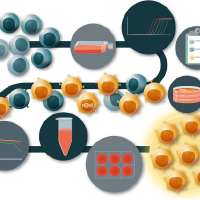Using Machine Learning for Critical Quality Attribute Discovery in Cell Therapy Manufacture
Cell & Gene Therapy Insights 2019; 5(1), 85–96
10.18609/cgti.2019.011
Stem cell-derived cellular therapies are currently entering clinical trials for several degenerative diseases. For these therapies to be commercially viable, it is necessary for manufacturing to be adapted to commercial scale. Though, before bioreactors and multi-layered flasks are capable of producing hundreds and thousands of clinical doses, it is important to examine the assays and criteria for assessing a cell therapy’s safety and potency. Unlike molecular drugs, a stem cell-derived therapy comprises processed, living material consisting of millions of individual cells. The potency of the therapy is not simply related to a molecular formula, or confined to a single biological molecule; it depends on the complex cellular machinery, and more often than not, on the dynamic interplay between different cellular populations. Further, cell therapies may change or differentiate during the multistep process of transplantation, integration and maturation. The complexity of this multifaceted process must therefore be reflected in the quality control mechanisms employed during manufacture, especially as scaling and good manufacturing practice (GMP) adaptation may lead to unforeseen permutations. FDA, under the Process Analytic Technology framework, has prescribed that manufacturers adopt a set of Critical Quality Attributes (CQAs) that can be assessed during manufacture under a Quality by Design process regime [1,2]. With the aid of Machine Learning (ML) techniques, discovery of new CQAs is now possible for cell therapies. ML offers a set of mathematical mechanisms for discovery and prediction that would allow for the distillation and online evaluation of QCAs from large, traditionally unwieldy data sets. When coupled with a comprehensive data collection program guided by statistical design of experiments (DOE) methodology, these newly discovered CQAs may be assessed and implemented in GMP manufacture using a statistical process control (SPC) program to ensure process reliability and fidelity. In this article we outline three techniques that, when combined with ML, can help define CQAs of a cell therapy manufacturing process.
